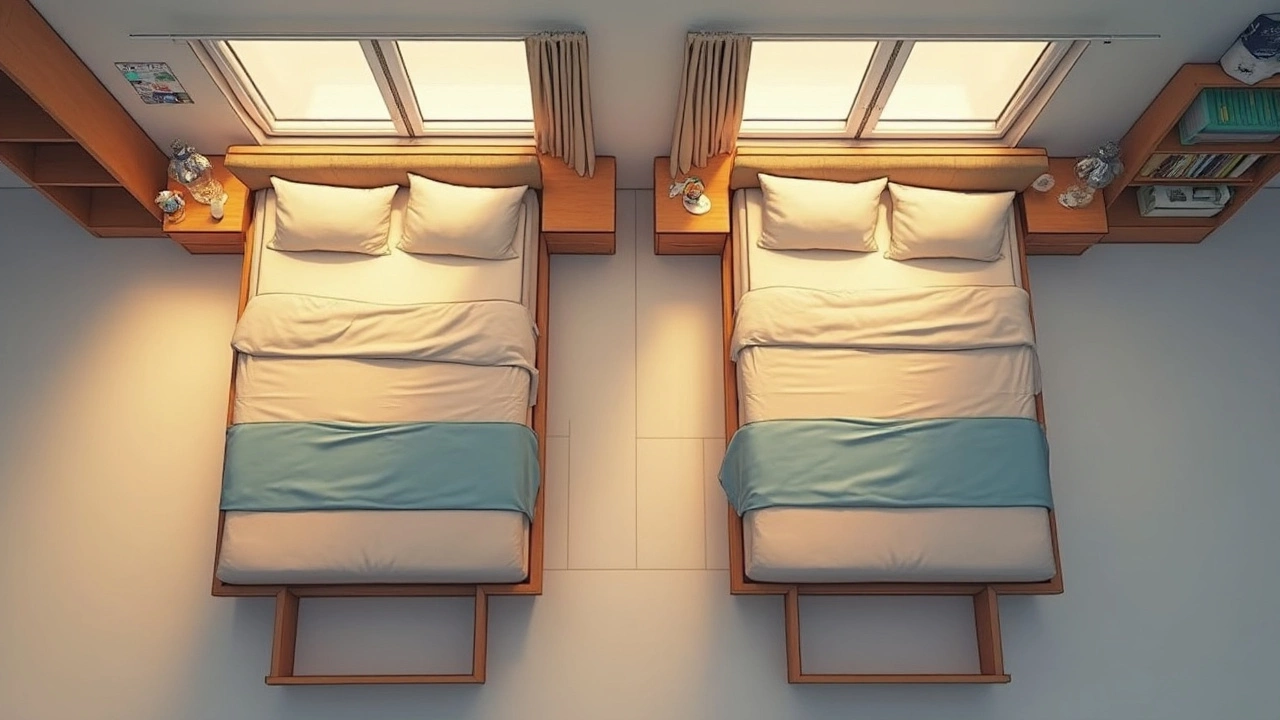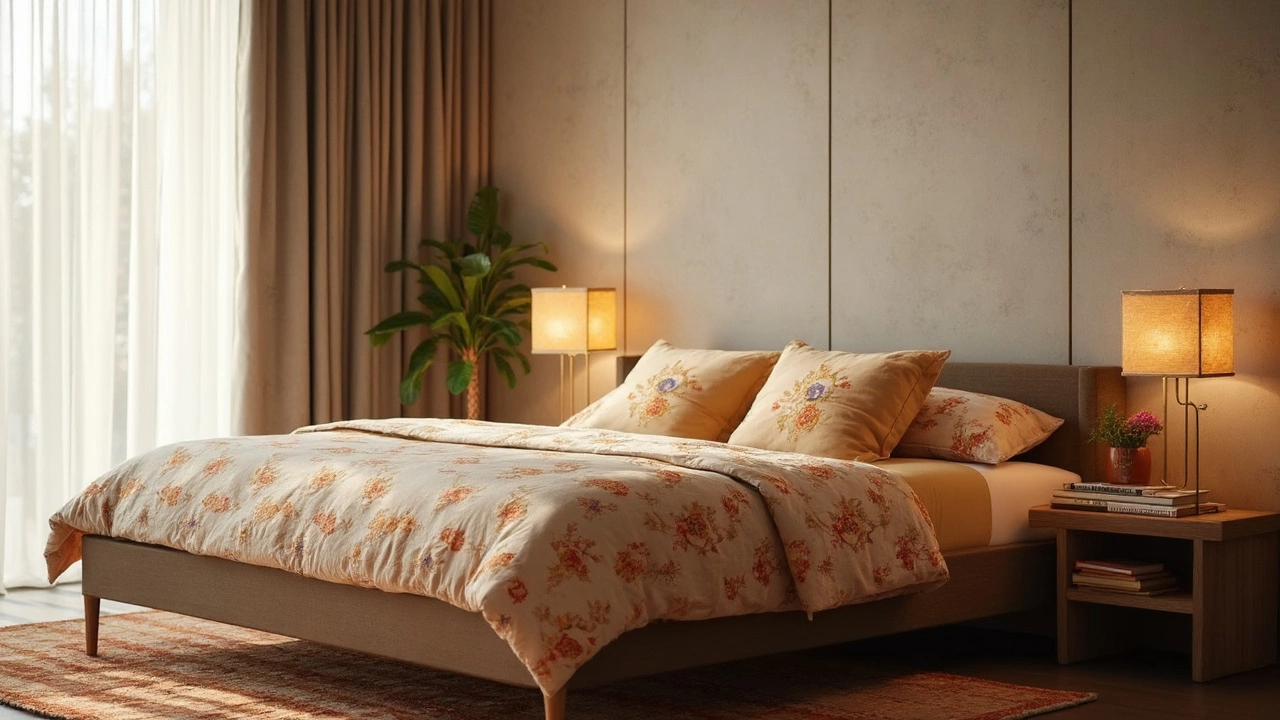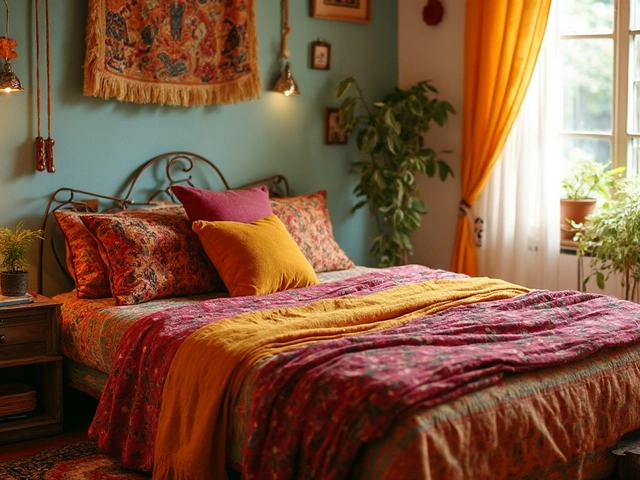Stop for a second and picture rolling over in bed at 2 a.m. to grab your phone or a glass of water. If your nightstand is too high, you’re stretching like you’re training for the Olympics. Too low, and you’re half off the bed, basically in plank position. Getting the height right is not just about what looks good—it’s about what actually works on a daily basis.
Most furniture stores sell nightstands as a matching set with beds, but real life isn’t always that tidy. Mattress heights have changed a ton thanks to deep mattresses and box springs, so the old “every nightstand fits every bed” idea is toast. If you just bought a new bed, or you’re looking to swap nightstands, you need to know what height actually makes sense—not just what the catalog says.
- The Real Reason Nightstand Height Matters
- What Designers Say About the Perfect Height
- Pros and Cons of Higher Nightstands
- Pros and Cons of Lower Nightstands
- Easy Tips for Picking the Right Height
- Final Thoughts: Making It Work in Your Room
The Real Reason Nightstand Height Matters
Have you noticed how some bedrooms just feel easy to use, while others seem like everything's awkwardly out of reach? Nightstand height is a sneaky detail that actually makes a big difference—way more than most people think. It’s not just about what’s trendy or trying to match your furniture sets. If you don’t get this right, you’ll be annoyed every single day.
The big thing comes down to comfort and function. According to the Sleep Foundation, picking the wrong nightstand height can “lead to awkward stretches or even spilled drinks” when you try to grab stuff from your bedside. Here’s what interior designers keep repeating: the ideal nightstand height puts your essentials—phone, book, lamp, glass of water—right at your fingertips when you’re lying in bed. No reaching, no twisting.
"A nightstand should be roughly level with the top of your mattress—within two inches up or down," says designer Emily Henderson. "Anything much higher or lower messes with the flow and feels awkward to use."
Surprising fact: The range of modern mattress heights has actually changed the game. Twenty years ago, mattresses averaged about 8 inches thick, but now the average is around 12–15 inches, and some pillow-tops go to 18! Take a look:
| Year | Avg. Mattress Height (inches) |
|---|---|
| 2000 | 8–10 |
| 2020 | 12–15 |
| 2025 | 15–18 |
If your nightstand is stuck at the old standard (about 24 inches tall), but your bed is now 28 inches off the floor, reaching over feels way off. Or if the table’s way lower than the bed, you end up knocking over your alarm clock every morning.
The nightstand height question gets even more important if you share your room, have kids, or just like having snacks or tech nearby. Basically, getting this one detail right actually removes daily annoyances you might never realize are avoidable.
What Designers Say About the Perfect Height
If you’re wondering how tall your nightstand should be, interior designers have surprisingly clear advice. The sweet spot is usually for the nightstand top to be level with, or just an inch or two above, the top of your mattress. Why? It’s all about reaching for your phone, lamp, or glass of water without twisting your arm or straining your back.
The advice comes up again and again in design guides. In fact, the popular website Apartment Therapy puts it simply:
“The top of your nightstand should be even with or slightly higher than the top of your mattress—within about 2 inches is ideal.”
This rule isn’t just a style thing; it’s practical. If the nightstand height doesn’t match, you’re going to notice every single night. Imagine dropping your glasses and searching for them somewhere below your bedframe—nobody enjoys that.
Here’s what the numbers usually look like in real life:
| Bed Type | Average Mattress Height (inches) | Ideal Nightstand Height (inches) |
|---|---|---|
| Standard Bed | 24 | 24–26 |
| Pillow-Top Mattress | 28 | 28–30 |
| Platform Bed | 18 | 18–20 |
If your mattress is extra thick thanks to today’s beefy bedding trends, you may have to hunt for slightly taller nightstands. Conversely, if you sleep on a low platform bed, short nightstands make life a lot easier.
Designers say that mismatch in height can throw off the whole look of your room. But it’s the ergonomics that make people notice. If it feels awkward to reach your water glass, it’s a sign your nightstand is off. As a good rule: 1-2 inches taller than your mattress is perfect, but don’t go more than 4 inches above or below that mark—you’ll regret it.
Pros and Cons of Higher Nightstands
People sometimes pick higher nightstands because they look bold or match a tall bed. But does a taller nightstand actually make your life easier, or is it all just for style points? Here’s the real story.
- Pro: Easy Access for Tall Beds — If you’ve got a bed with a thick mattress or a pillow-top, a higher nightstand usually lines up better. That way, you’re not reaching way down for your alarm, glasses, or a glass of water.
- Pro: More Storage — Most high nightstands come with extra shelves or drawers. You get more room for stuff like books, remotes, and chargers, which actually helps keep things tidy.
- Pro: Works for Tall Users — Taller folks often find it more comfortable to reach across to a higher surface. If you’re over 6 feet, this setup just feels more natural.
- Con: Awkward for Low Beds — If your bed is on the lower side, a tall nightstand is just going to look and feel off. You might find yourself knocking stuff over as you reach up awkwardly in the dark.
- Con: Can Look Out of Place — Too much height difference between your bed and nightstand makes your bedroom look mismatched. It can throw off the whole vibe, even if everything else is coordinated.
- Con: Risk of Injury — There’s a reason furniture designers suggest keeping nightstands close in height to your mattress. Higher edges can turn into obstacles, especially if you’re groggy and stumble out of bed in the morning.
Here’s a quick data snapshot so you can see how common higher nightstands are and where they work best:
| Nightstand Height | Best Bed Height Match | Common Usage (%) |
|---|---|---|
| 28-32 inches | 25+ inch mattress & frame | 41% |
| 24-27 inches | 20-25 inch mattress & frame | 46% |
| Below 24 inches | Low platform beds | 13% |
If you end up with a higher nightstand next to a shorter bed, it might seem fine at first. But give it a week or two, and you’ll probably notice it’s a pain for things like charging your phone or hitting snooze. The basic rule? Your nightstand height should be no more than two inches above your mattress, or it starts to feel like a stretch—literally. If you do go higher, it’s usually for beds that are already high off the ground.

Pros and Cons of Lower Nightstands
Going with a lower nightstand is a move you’ll see in a lot of Pinterest-worthy setups, but it’s not all about trends. There are some real reasons people pick them—and some headaches to know about too.
nightstand height is about more than matching furniture; it’s about how you live day-to-day. Here’s a quick breakdown of what rocks (and stinks) about keeping things on the lower side.
- Pro: Easy For Low Beds — If you have a platform bed or a mattress that sits close to the ground, a lower nightstand is way less awkward. You can just reach sideways instead of stretching up or risking spilling your drink on the carpet.
- Pro: Minimalist Look — Lower stands tend to make a room feel more open and have a cool, modern vibe. They don’t dominate the space, and your room can look less cluttered.
- Pro: Kid-Friendly — For little kids, lower nightstands are easier to access. Perfect if you’re setting up a child’s room.
- Con: Awkward With High Mattresses — If you have one of those super-thick beds, a low nightstand basically turns useless for late-night glass grabs or hitting the snooze button.
- Con: Storage Limitations — Most lower nightstands are smaller, so you lose out on space for books, chargers, or whatever else you pile on.
- Con: Not Always Great For Decor — Lamps and décor might look odd if they sit way below your bed’s top. The scale gets weird.
Here’s what people usually find helpful when deciding on a height. Check out this quick look:
| Bed Height | Recommended Nightstand Height | Common Issues With Lower Nightstands |
|---|---|---|
| 18-22 inches | 16-20 inches | Harder to see lamp, less storage |
| 24-30 inches | 18-24 inches | Uncomfortable reach for bedside items |
If you’re leaning toward a lower option, just make sure your bedside essentials stay within easy reach. And don’t forget, a too-short nightstand can mess with the look and feel of your whole room, not just your sleep routine.
Easy Tips for Picking the Right Height
So, what’s the sweet spot for nightstand height? The rule of thumb is simple: aim for your nightstand’s top to be roughly level with the top of your mattress or just a smidge higher—think one or two inches at most. If you go much lower or higher, grabbing stuff in the middle of the night turns into an awkward workout.
The standard bed height these days lands anywhere from 24 to 30 inches off the floor (mattress included). Most nightstands are built around 24 to 28 inches tall. Before you shop, grab a tape measure and check the distance from your floor to the top of your mattress. Not all beds are created equal—pillow-top mattresses and beds with box springs can add serious height, so check your own setup instead of guessing.
Here’s how to get the nightstand height right, step by step:
- Measure your bed height. Start from the floor, go up to the tip-top of your mattress. Jot down the number.
- Match or go slightly higher. Aim for a nightstand that’s exactly the same height or up to two inches taller. Going much higher can be annoying, especially if you’re reaching in the dark.
- Test with books or boxes. If you already own a table you like but it feels too short, try stacking a few thick books underneath. Still functional, and it lets you ‘cheat’ the height until you find a long-term fix.
- Account for bedside basics. If you use a chunky alarm clock, a lamp base, or keep stacks of books next to your bed (guilty), factor in how cluttered the surface will get. A bigger nightstand helps if you’re a maximalist, but the height rule still applies.
- Skip ‘matching set’ pressure. Your nightstand doesn’t need to be part of a matching set. Focus on function first—grab a small dresser, a sturdy side table, or whatever feels right at your bedside height.
Getting your nightstand height right makes everything smoother, from charging your phone to grabbing a glass of water. Plus, it just looks more polished and intentional, like you actually thought about comfort, not just what looked fancy on Instagram.
Final Thoughts: Making It Work in Your Room
There’s no universal rule for nightstand height. But here’s the deal: Most designers agree your nightstand should line up within 2-4 inches of your mattress height. If your mattress sits at 25 inches, for example, you’re looking at a nightstand between 23 and 27 inches tall. This little detail can change how you use your bedroom every single day—no more awkward stretching or diving for your alarm.
Still, nothing’s set in stone. Some people go for a bit higher if they want extra storage space or a lower look to keep things feeling modern and open. Here’s a cheat sheet in plain English:
- If your bed is on the higher side (28 inches or taller), don’t be afraid to look outside the “nightstand” section—check small dressers or even sturdy side tables.
- For lower beds, look for nightstands closer to 20 inches. If you can’t find one, a stack of nice storage boxes or a reclaimed wood crate can work in a pinch.
- Test it in your room before you commit. Stack some books to your potential nightstand height and try reaching for your phone or water at night. If it’s weird or uncomfortable, keep looking.
If you’re into details, check out this simple comparison table for quick reference:
| Mattress Height | Suggested Nightstand Height Range |
|---|---|
| 20" - 22" | 18" - 24" |
| 23" - 25" | 21" - 27" |
| 26" - 28" | 24" - 30" |
In the end, the sweet spot comes down to what feels right when you’re actually using your space. Trends come and go, but comfort and convenience stick around. Try different heights until your nightstand works for your routine—that’s what really counts.





